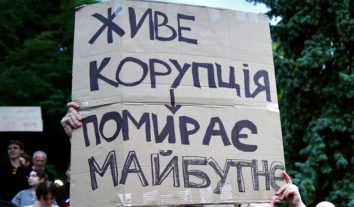Three stories of women taken by Russians as civilian hostages from Kherson
Last year in autumn, Russians who held Kherson and the surrounding settlements began preparing to retreat. They were taking equipment, documents, personnel, and civilian hostages held in the city’s torture chambers to the left bank of the region.
On October 20, 2022, 36 prisoners were taken from the Kherson temporary detention center. Among them were four women, including Olga Cherniak and Svitlana Shukailo. They were first brought to Hola Prystan and later to Novotroitske, settlements on the Kherson’s left bank, where they spent more than six months.
In May 2023, Russians took the women from the police station in Novotroitske and left them on the outskirts of the occupied city. They had to travel about 4,500 kilometers (~2800 miles) to return to the government-controlled territories of Ukraine.
Olha and Svitlana told ZMINA about how Russian occupying forces took prisoners, hastily prepared new cells for them, and held civilian hostages on the occupied left bank of the Kherson region.
 A collage made by ZMINA
A collage made by ZMINABefore the full-scale invasion, Olga Cherniak worked as the chief state social inspector in Kherson. Even after the occupation, she and her colleagues continued to work.
However, on August 10, 2022, the woman was detained. She was sent to a temporary detention center at 3 Teploenergetikiv Street.
The Russians accused the official of collaborating with the Ukrainian military and wanted her to confess at any cost.
She was taken into a room where screams were regularly heard and sat down in a chair. Wires were connected to her fingers, and interrogation began. Russians occupying forces used electric shocks until Olga started to lose consciousness. She had a heart attack in the cell.
A “criminal case” was opened against Olga. However, the woman was never informed of what she was accused of.
The prisoner spent more than two months in the detention center. She was taken for interrogation three times. She was forced to write what the Russian representatives wanted. They intimidated her, telling her that she would be transferred to Donetsk, imprisoned for ten years, and tortured all the while.
Eventually, Olga became one of the civilian hostages taken by the occupation forces to the left bank of the Kherson region in late autumn of 2022.
 A photo of the building of the Kherson detention center. Credit: ZMINA
A photo of the building of the Kherson detention center. Credit: ZMINA“Everyone is allowed to go home”
On October 18-19, an unprecedented movement began in the Kherson temporary detention center: people were called out of their cells and told that they would release everyone. This is how Olha recalls those days. She had been held in the temporary detention center for three months, and most of all, she hoped to get out of there.
As it turned out later, some of the hostages were indeed released, the former prisoners say. Still, most were transported to other places of detention, such as the one in Simferopol (occupied Crimean peninsula) and illegal detention centers in Kalanchak and Genichesk in the southern part of the Kherson region.
At about three in the morning on October 20, Olga and her cellmate were woken up and told to pack their things because they were being released.
“We believed them. We were going home, happy. But it did not happen as expected,” says Olga.
At first, the woman was left in a so-called “glass” – a small and narrow cell where one person can sit or stand.
Russians took her out of there, put her in a police car, sent her back to the “glass” again, and finally put her in another vehicle with three other women. All of them had already realized that no one was going home.
Svitlana Shukailo was among the hostages in the car. Before the full-scale invasion, she worked as the deputy director of the Kherson branch of the Institute of Soil Protection. When the Russians seized Kherson, she stayed home, cared for her elderly parents, fed stray animals, and, together with other citizens, helped bake bread for residents of a suburban village.
The Russians detained Svitlana on August 17 (2022). Like many other civilian hostages, she was accused by the Russian military and security forces of collaborating with the Armed Forces of Ukraine.
At the time of her transfer, she had been held in a detention center in Kherson for over two months.
When the Russians came to her cell on the night of October 20 (2022), she did not even hope that they would release anyone.
“We guessed that something serious was happening. We heard the sounds of explosions more often and louder. We realized that we were about to be dragged to the other side [left bank of the Kherson region],” says Svitlana.
According to the women, at least eight trucks with prisoners left Kherson that day. Olga heard one of the heads of the temporary detention center, Andriy “Zlyy,” [Angry] say that he sent five trucks to the Kherson pre-trial detention center and left three for the temporary detention center.
On October 20, the Russians took 36 hostages from the detention center alone.
“We were used as a cover for the military equipment when it was being transported across the Dnipro River,” says Olga.
According to her, the Russians drove military equipment onto pontoons [during their retreat], with trucks with prisoners between them.
“It was terrifying. We were afraid that no one would save us,” she adds.
Next to the prisoners in the car, there were cans of gasoline. The pungent stench of the fuel made the women feel sick. They asked to open the windows but were ignored until Olga began to lose consciousness. Then, she suffered another heart attack.
Intermediate stop
All 36 prisoners were brought to the temporary detention center in Hola Prystan.
“Armed soldiers were standing along the corridor. They were shouting at us and pushing us into cells that were already open,” Olga recalls.
 A collage made by ZMINA
A collage made by ZMINAThe four women were placed in cell No. 9, designed for two people.
“It was dirty, dark, and cold inside. There was a strong stench,” says Svitlana.
There was a window in the cell, but it was impossible to open it, she adds.
For the first few days, the hostages were not fed at all. The only food they had was what they managed to take from the temporary detention center – some apples, cookies, dried goods, and other small items, the women recall.
“At first, we were treated like prisoners,” Svitlana recounts her first days in Hola Prystan, “but when they told us we were prisoners, they started to treat us a little better. Even the senior officer there, Volodymyr Volodymyrovych, began to look at us differently.”
Volodymyr Volodymyrovych is a local collaborator who used to work in Holoprystan Penal Colony No. 7 in Zburivka, the women say.
A few days later, the locals learned that new prisoners had been brought to the temporary detention facility and began sending food there through the warden. Volodymyr accepted both ready-to-eat food and food that his wife cooked for the hostages.
However, the former prisoners emphasized that there was not enough food for everyone. The guards often handed out something that looked like porridge, but it was impossible to eat, the women recall, so they threw it away.
The women and most of the other prisoners spent ten days in Hola Prystan.
On the morning of October 30, the prisoners were again ordered to pack their belongings, put in vans, and taken to the east, to the deep rear.
Stench, suffocation, and starvation
The cars with the prisoners first arrived in Chaplynka. The Russians left about ten hostages there. The rest were taken to Novotroitske, where they were placed in the police station.
There, the prisoners were met by a local collaborator, Eduard Bondarenko. He asked if the prisoners had mattresses with them.
“Sorry, we didn’t have time to prepare,” the woman sarcastically replied.
The premises were not designed to hold so many prisoners – there were only two cells for administrative offenders in the district police station. According to the women’s recollections, these cells were no more than 2 meters wide and 2.5 meters long, but sometimes up to 15 male prisoners were held in each cell.
“We were shoved into an empty room with bare walls: no outlet, tap, or toilet. One window and it was boarded up with chipboard,” Svitlana describes their third place of detention.
It was a small room on the ground floor that once served as an archive. Near the office, there was a guardhouse where guards were constantly on duty.
Late in the evening of October 30, two mattresses were brought to their room. They were dirty and smelled of urine.
“We covered them with our blankets and sheets from Kherson. That’s how we spent the first night,” says Svitlana.
The women describe their stay at the police station as sophisticated, planned, and long-lasting torture.
“It seemed like nothing, but the room had no ventilation, no daylight, and you couldn’t even go to the toilet – you had to ask,” Svitlana says.
According to her, the women were taken to the restroom three times a day – not according to a schedule, but whenever the guards wanted.
The prisoners also could not regularly wash in more or less normal conditions – for more than six months of their stay in Novotroitske. The women were taken to the shower about three times.
“We had a small bowl in which we put hot water. The guards brought it to us in kettles. We were constantly wiping ourselves off to keep ourselves in good shape,” says Svitlana.
However, they sometimes had to beg for hot water, as well as for anything that could make their stay in detention a little easier.
Because of the stuffiness, the women were constantly feeling sick and had to call doctors. Eventually, only after a month and a half of their stay there did the guards agree to cut a small window in the chipboard to let fresh air into the room.
“The shutters behind the chipboard were made of steel. So we could only see a strip of light through them,” Svitlana recalls.
Due to the lack of fresh air, the prisoners were constantly sleepy. After two weeks in the cell, the women noticed that their muscles began to ache without physical activity.
“We could only walk around the perimeter of our mattress, so we mostly either sat or lay down,” recalls one of the former hostages.
At first, women were not even provided with hygiene products:
“I’m 47 years old, and I’m standing there telling a thirty-year-old snot-nosed brat that I’m on my period and need pads. “What are you looking at me for?” I said, “I didn’t ask you to steal me from my house and bring me here,” Olga says.
Afterward, the women were brought shampoo, soap, powder, and pads.
One day, the collaborators-watchers told the women that all the hostages would be released from the detention center by the New Year. However, time passed, and there was no more talk of release.
“Every day, we lost hope. It’s already December 30. It’s already December 31. It’s already January, and no one remembers us,” Svitlana recounts her experiences.
The uncertainty and lack of information about the future was the most depressing thing for the hostages. Every time the cell door was opened, the women asked when they would finally be released.
They tried by all means to draw attention to themselves and achieve, if not release, then at least the announcement of the grounds for their detention.
According to the women, they were told in the Kherson temporary detention center that criminal proceedings had been initiated against them. Still, in Hola Prystan, the warden said that no materials from their cases had been handed over to him.
In early March, representatives of the Russian Federal Security Service (FSB) came to Novotroitske. They promised the women a “gift” for March 8 – release. However, this did not happen.
In mid-March, Olga suggested that Svitlana go on a hunger strike.
“They thought it was not serious, but we refused everything for ten days,” Olga recalls.
The women ate only bread and took warm water for tea.
At first, the hunger strike worked – the detention center staff visited the women, and a request was made to the central police to see if there was anything to keep them in custody. However, that was the end of it.
In April, the Russians changed the administration of the region. They appointed another head of the convoy service and the head of the temporary detention center.
The women recall how outraged the newly appointed head of the detention center was. However, he did nothing to change the conditions of imprisonment.
He also asked whether the prisoners were well-fed. In response, the women offered him to taste the “food” himself.
“The canned meat was such that it didn’t sink in the toilet. You opened them, and you started vomiting. But we had to eat this because there was nothing else,” Olga recalls.
Usually, the prisoners received two packs of instant noodles and a can of canned meat for the whole day for five people, Olga says. There was no drinking water in the cell – only from the tap.
“It was scary. I never thought I would pick up crumbs from the table, eat them, and be happy. That I would cry when given boiled potatoes,” says Olha.
This diet aggravated her allergies, and she developed rashes on her body that could not be treated adequately in those conditions.
4500 kilometers back home
Occasionally, representatives of the occupation authorities and the Russian military visited the temporary detention facility. For example, one day, the police chief of the Genichesk district, appointed by the occupiers, arrived.
He came into the room where the women were being held and saw a homemade calendar – Olga had marked on the wall every day she was in captivity. It was 235 days. Svitlana recalls how the military officer grumbled that it was a long time, but it did not change the women’s situation.
In May, another high-ranking officer arrived at the Novotroitsk police station. The women heard him call a general.
Olga managed to overhear his conversation with the local occupiers and collaborators: he gave them 120 hours to sort the prisoners:
“If there is a case, punish them. If not, let them go,” the general ordered.
A few days later, on May 17, two more representatives of the occupiers came to the detention center and summoned Olga.
At first, they told her how “wonderful Russia is,” she recalls. After that, she was ordered to write three receipts.
In the first one, the military demanded that she state that she did not know how she ended up at the Novotroitsk police station.
“What do you mean I don’t know?” Olga was outraged. “I was kidnapped from my home, brought to the detention center, transferred to Hola Prystan, and then here. I have been held here for almost seven months.”
The military officer replied that she would write what she was told or continue to be held in the department.
In the second receipt, she wrote under dictation that there was neither physical nor psychological torture in the police station. Therefore, she had no complaints against the police department’s management.
The last piece of paper stated that Olga had received all her belongings.
After that, the woman was ordered to go pack, and she asked if Svitlana would be released. However, the Russians planned to release the women “one a day.”
“I won’t go like that. Where will I go without her? If you don’t let her go, I’ll be in jail too,” the woman told the occupiers.
It worked – Olga was sent to pack her things, and Svitlana was called to write the same receipts.
The women were put into a white minibus, bags were put over their heads, and taken away from the police station.
After about 15 minutes, the car stopped. The prisoners were taken out, stood facing the fence, had their bags removed, and were ordered to count to 50 – only then were they allowed to turn around and leave.
“When we found ourselves on the street, we were in such a strong shock. I could not believe what I was feeling. I couldn’t believe that I was finally free,” Svitlana recalls the moment she stood under the fence.
In total, she spent 273 days in Russian captivity, and Olha spent 280 days.
The next step for these women was to return home, so immediately after their release, they started looking for ways. The only way to leave the occupied territories of the Kherson region was through Crimea and from there to Russia, and this was the biggest fear for the women.
“I waited for Olga at Chongar for over an hour. I was already afraid that she had been detained again,” Svitlana recalls.
Meanwhile, her friend was being scrutinized.
“They made me lift my shirt and show my knees – they checked if I had any bruises, wounds, or tattoos. A man examined me again,” says Olga.
The women managed to leave for Rostov and from there – via Moscow – to the Baltic States, Poland, and eventually back to Ukraine.
The former prisoners were taken from the Kherson detention center to the village of Novotroitske in one day. But the journey back took the women almost four days.
Captivity left severe imprints on their health. In particular, Olga had seven heart attacks during her time in detention. The women have already been treated twice in a hospital and are still undergoing physical and psychological rehabilitation.
Other women held in the Kherson detention center were released even earlier. The stories of some of them were documented and analyzed by ZMINA in the report “Women’s cells of the Kherson torture chamber: an analytical report based on the testimonies of the detainees.”









